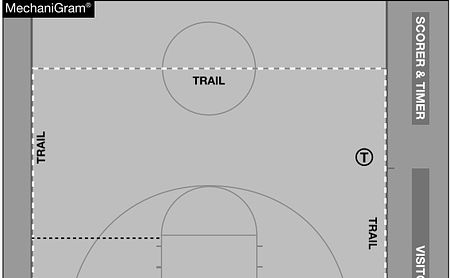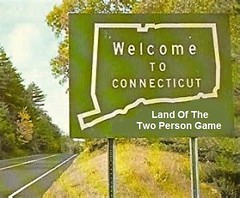
 |
|
|||
|
This is the Lead's line. The Trail should only signal if the Lead is asking for help. Similar to a ball coming from the Trail being thrown to the endline.
They seem to get this right but it could have been a disaster if both did not agree. That is why the Trail waits for an indication of help. Peace
__________________
Let us get into "Good Trouble." ----------------------------------------------------------- Charles Michael “Mick” Chambers (1947-2010) |
|
|||
|
New IAABO Line Responsibility Mechanic ...
Quote:
But as much as I hated the change (with so much intense hatred by many veterans that they refused to use the new IAABO line responsibility mechanic, and said so in their pregame), I did understand the IAABO rationale of pairing this sideline responsibility with one's primary coverage area.
__________________
"For God so loved the world, that he gave his only begotten Son, that whosoever believeth in him should not perish, but have everlasting life." (John 3:16) “I was in prison and you came to visit me.” (Matthew 25:36) |
|
|||
|
Shouldn't Be Looking There, No Ball Watching ...
Quote:
While I've always disliked this "new" IAABO line responsibility mechanic, I do find myself doing less sideline above the free throw line extended ball watching as the Lead.
__________________
"For God so loved the world, that he gave his only begotten Son, that whosoever believeth in him should not perish, but have everlasting life." (John 3:16) “I was in prison and you came to visit me.” (Matthew 25:36) |
|
|||
|
NFHS Line Responsibility Mechanic ...
Nice citation from the NFHS. I didn't realize that IAABO and the NFHS were so different. Makes for some nice discussion here on the Forum.
__________________
"For God so loved the world, that he gave his only begotten Son, that whosoever believeth in him should not perish, but have everlasting life." (John 3:16) “I was in prison and you came to visit me.” (Matthew 25:36) |
|
|||
|
Frontcourt Endline Line Responsibilities ...
Quote:
Quote:
Technically, according to both the NFHS and IAABO, out of bounds is a violation (like any other violation) and should be called when it occurs in one's primary coverage area. And yet, the frontcourt endline responsibility is solely the Lead's responsibility in both NFHS and IAABO mechanics. Just proves that three heads are better than two.
__________________
"For God so loved the world, that he gave his only begotten Son, that whosoever believeth in him should not perish, but have everlasting life." (John 3:16) “I was in prison and you came to visit me.” (Matthew 25:36) Last edited by BillyMac; Sun Sep 05, 2021 at 04:12pm. |
|
|||
|
This is from the NASO Mechanics Illustrated Book for 2021-2022.
 Quote:
Peace
__________________
Let us get into "Good Trouble." ----------------------------------------------------------- Charles Michael “Mick” Chambers (1947-2010) |
|
|||
|
Rookies, Can't Live With Them, Can't Live Without Them ...
Quote:
However, now, after this thread, I might rethink my constructive criticism, possibly toning down my criticism. Also, as a member of my local board's mechanics training committee, I'm wondering if we should rethink our training methods.
__________________
"For God so loved the world, that he gave his only begotten Son, that whosoever believeth in him should not perish, but have everlasting life." (John 3:16) “I was in prison and you came to visit me.” (Matthew 25:36) |
|
|||
|
NASO Mechanics Illustrated ...
Quote:
__________________
"For God so loved the world, that he gave his only begotten Son, that whosoever believeth in him should not perish, but have everlasting life." (John 3:16) “I was in prison and you came to visit me.” (Matthew 25:36) |
|
|||
|
Three Heads Are Better Than One ...
Quote:
Shooting from the hip, the best I can come up with for two person games is for both sideline responsibilities, and frontcourt endline responsibilities, to be covered as part of one's primary coverage area, and let the chips fall where they may. It may cut down on some ball watching, and out of bounds is a violation (like any other violation) that should be called when it occurs in one's primary coverage area. Tough calls can be solved by asking for help, offering help, or using the alternating possession arrow. Or turn over the NFHS/IAABO conflict to the United Nations Security Council.
__________________
"For God so loved the world, that he gave his only begotten Son, that whosoever believeth in him should not perish, but have everlasting life." (John 3:16) “I was in prison and you came to visit me.” (Matthew 25:36) Last edited by BillyMac; Sun Sep 05, 2021 at 01:08pm. |
|
|||
|
I was always taught to have the "L" coverage. The Trail has the division line and the sideline they are on. And the Lead has the endline and the sideline they are on. Two-person coverage is flawed, so if you have it you are going to have to do things you would not need to do with a 3rd official out there. But not sure how the Trail can clearly know that the ball was knocked out on the offensive player. The Lead's positioning is also poor as he is sticking to the lane it appears. This play might not have been as bad, but if there is a play near the line and someone is stepping on the line, the Trail has no chance. The Lead has to make those kinds of calls.
Peace
__________________
Let us get into "Good Trouble." ----------------------------------------------------------- Charles Michael “Mick” Chambers (1947-2010) |
|
|||
|
Two-Person Coverage Is Flawed ...
Quote:
The only problem is when the Lead is paying close attention to some real basketball action in his primary coverage area in the lane, maybe two post players trying to dominate each other as they fight for position, and/or screens being set at the elbows, or at the blocks. The Lead can't be ball watching looking for a ball handler to step on the sideline out near the division line. While good officials should be always be aware of where all the players are, and where their partner is, we all know the problems that can occur with ball watching. Quote:
__________________
"For God so loved the world, that he gave his only begotten Son, that whosoever believeth in him should not perish, but have everlasting life." (John 3:16) “I was in prison and you came to visit me.” (Matthew 25:36) Last edited by BillyMac; Sun Sep 05, 2021 at 05:25pm. |
|
|||
|
Old Man (Neil Young, 1972) ...
Quote:
And remember, I officiate in Connecticut, so not only am I familiar with both systems, but I'm also waht'cha call a two person game expert. 
__________________
"For God so loved the world, that he gave his only begotten Son, that whosoever believeth in him should not perish, but have everlasting life." (John 3:16) “I was in prison and you came to visit me.” (Matthew 25:36) Last edited by BillyMac; Sun Sep 05, 2021 at 01:54pm. |
|
|||
|
Quote:
Sent from my SM-N950U using Tapatalk
__________________
A-hole formerly known as BNR |
|
|||
|
Walk And Chew Gum ...
Quote:
Breaking News: Connecticut Game Fees for 2021-22 Season: Scrimmage Fee: $150 (3 officials $50 each, 2 officials $75 each); Varsity Fee: $101.69; Sub Varsity Fee: $65.99 (Junior Varsity, Freshmen, Middle Schools). I used the NFHS system for decades and it can work, and sometimes work quite well, otherwise the NFHS wouldn't have stuck with it for such a long time. Quote:
Quote:
Neither two person boundary line system is any where near perfect.
__________________
"For God so loved the world, that he gave his only begotten Son, that whosoever believeth in him should not perish, but have everlasting life." (John 3:16) “I was in prison and you came to visit me.” (Matthew 25:36) Last edited by BillyMac; Sun Sep 05, 2021 at 02:21pm. |
|
|||
|
Watching your sideline does not mean ball watching. It means being aware when the ball goes out on your sideline.
Sent from my SM-N950U using Tapatalk
__________________
A-hole formerly known as BNR |
 |
| Bookmarks |
|
|
 Similar Threads
Similar Threads
|
||||
| Thread | Thread Starter | Forum | Replies | Last Post |
| Out of Bounds? | jsblanton | Basketball | 10 | Fri Oct 24, 2008 04:11pm |
| Help-Player in bounds and out of bounds | RecRefNC | Basketball | 15 | Mon Dec 06, 2004 10:46am |
| Interception out-of-bounds tossed to another player in-bounds | mrcrumley | Football | 22 | Wed Oct 27, 2004 07:32am |
| Out of bounds ? | Texoma_LJ | Football | 15 | Fri Oct 08, 2004 03:50pm |
| out of bounds? | 99cnthmbrgr | Basketball | 2 | Mon Apr 05, 2004 07:09pm |